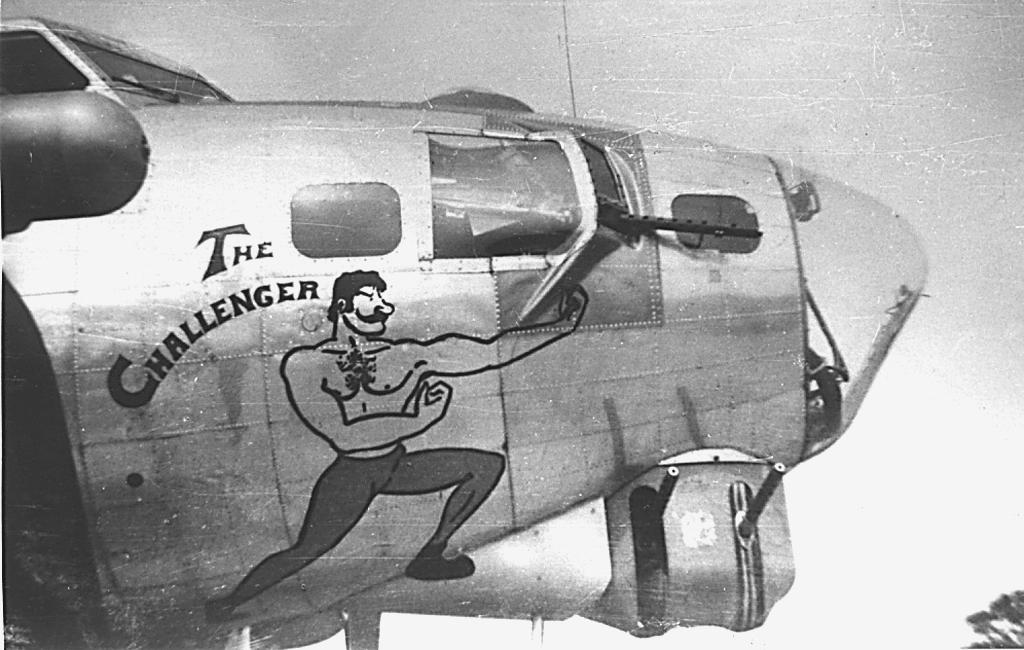 zoom_in
zoom_in
Source:
photos.384thbombgroup.com
Production-block:
B-17G-50-BO: 42-102379 to 42-102543
Manufacturer:
Boeing
- Bomb Group:
- 384th Bomb Group
- Bomb Squadron:
- 546th Bomb Squadron
- RCL: BK-H
MACR: 15315
History of
B-17 42-102501 / The Challenger
Delivered Cheyenne 9/3/44; Gr Island 11/4/44; Dowe Fd 28/4/44; Assigned 546BS/384BG [BK-H] Grafton Underwood 12/5/44; Missing in Action Berlin 3/2/45 with Robert Clax Long, Frederick Arnold Maki, Jack Coleman Cook (3 Killed in Action); Ralph John Vrana, Edward Field, Marvin Irving Rudolph, Howard Jasper Oglesby, Thomas Arnold Davis, Donald Ramsey Duncan (6RTD; flak, ditched in the North Sea; THE CHALLENGER.
Last updated: 5. February 2021
B-17 42-102501 / The Challenger Details
The following is a statement by 2nd Lt. Ralph J. Vrana, 546th Bomb Squadron, who was dispatched as co-pilot of the number seven aircraft, high section, hight squadron, 41st “B” Group on mission of 03 February 1945. The aircraft ditched in the North Sea at 5302N-0300E.
About a minute and a half before bombs away the number three and four engine were hit by flak. The manifold pressure in number three went down to about twelve and the oil pressure rapidly dropped and we were forced to feather it. The manifold pressure of number four fell at the same time but we kept it running. There were also flak holes throughout the right wing, the left Tokyo Tank hit and drained, plexiglass in the nose broken and several holes in the nose section of the aircraft.
There were no men wounded by this enemy action. We had enough power to stick with the formation on into the target and we dropped our bombs with the formation. We followed the group off the target but were dropping behind and I asked the pilot if he wanted to go to Russia but he said he would try and make it back to England.
We began losing about fifty to seventy-five feet per minute and our airspeed was 135 to 140 so we lost the group but followed the bomber stream on to the coast. The Gee-Box was not operating at our position when we neared the coast but we were still following the bomber stream. We were approximately at 17000 feet when we crossed the coast, where we received more flak but it was low and no further damage was inflicted on out aircraft.
Werbung/AdvertisementAt this time we started losing altitude more rapidly. We jettisoned the flak suits, ammunition, guns, heavy equipment and they were working with the ball turret but I don’t think they were able to get it clear off. The engineer tried to change the amplifiers to get more manifold pressure on the number four engine. When we reached 5000 feet we gave orders to prepare for ditching and threw our the rest of equipment that we could.
A B-17 on our right was flying along watching us and I think they radioed in our position. Our interphone went out when we got down to lower altitude so we were having to talk by passing the work along by mouth. The radio operator sent out S.O.S.’s until at about 500 feet when he locked his key and they all assumed their ditching position in the radio room except the pilot and myself who were in the cockpit.
We hit the water at 1315 hours. The ship bent in the middle slightly. The only man we knew that was injured to any extent in the ditching was the togglier who had some broken ribs and an injured leg. The navigator had a sprained ankle and the tail gunner was bruised some.
As soon as we hit the water we got out but the life raft handles wouldn’t come out. When we got out on the wing we pulled the extra handle and the rafts came out. Only one of them would inflate properly. The other one about half inflated. Some of the Mae Wests would only inflate partially also. A big wave came along and carried them both off so we were forced to swim for them.
The pilot swam thirty-five to forty yards to reach the fartherest raft, which was partially inflated. The rest of us swam for the other raft and Sgt. Cook, who arrived at it first, helped the rest of us in. The radio operator never did make it to the raft. We saw him and tried to row over but the waves were too high and we finally lost track of him as he drifted back towards the ship. Five of us were in our raft and the other two hanging on the sides.
We rowed over towards the pilot on the other raft. He had layed down as soon as he got on the raft and we hadn’t even saw him move since. While rowing over there the navigator, who had been outside of the boat for at least thirty minutes, got the cramps and Sgt. Cook got out of the boat and got the navigator back up to the raft and we pulled him in. Sgt. Cook wouldn’t get back in the raft but stayed outside and helped push the raft along by kicking his feed in the water. He was in the water about forty-five minutes before we reached the other raft.
Werbung/AdvertisementSgt. Cook and Duncan got into the raft with the pilot when we reached there. We bailed some of the water out of our raft and tried to bail it out of the other but it seemed to fill up faster than we could bail it out. We tried to pump the other raft up more but weren’t able to do so.
In the meantime the B-17 circled around and I guess he reported our position by radio. They also dropped a red flare. Three (3) PBY amphibious aircraft came over and a little while later some P-51’s went over. We fired flares on both occasions but they went on. A short time later Lt. Long started frothing at the mouth and talking out of his head. We tried all the harder to get the water bailed out of the raft but weren’t very successful. It was over forty-five minutes from the time he got on the raft before we reached him.
About 1715 we spotted two P-47’s and fired a flare. They came down and dropped smoke flares and then flew on East to pick up an Air-Sea-Rescue cutter, no. RML-523, which was about four miles from us. The pilot of the P-47 aircraft was Lt. Painter, Teamwork 31 Saffron Waldon, Essex, England. By the time the cutter got to us and picked us up Sgt. Cook started talking out of his head and Lt. Long was lying perfectly still. They took us aboard and worked on Lt. Long until we docked around four hours later.
There was no life in him at all. There was still a faint but of life in Sgt Cook and they gave him oxygen and artificial respiration but he died on the boat. They brought us into Milton Lodge.
Lt. Ralph John Vrana
Co-Pilot
Interview with Navigator Edward Field (engl.)
B-17 42-102501 / The Challenger Crew
| Position | Rank | Name | Status | Note |
|---|---|---|---|---|
| P | 2LT | Robert Cox Long | KIA | - |
| CP | 2LT | Ralph John Vrana | RSC | - |
| NAV | 2LT | Edward Field | RSC | - |
| ENG/TT | SGT | Howard Jasper Oglasby | RSC | - |
| RO | SGT | Fred Arnold Maki | KIA | - |
| BT | SGT | Jack Coleman Cook | KIA | - |
| WG | SGT | Donald Ramsy Duncan | RSC | - |
| TG | SGT | Thomas Arnold Davis | RSC | - |
| TOG | SGT | Marvin Irving Rudolph | RSC | - |






03. March 2024 access_time 10:26
My dad was the bombardier on the final flight of this aircraft. He spent years waking up screaming in the middle of the night with memories of that flight. He never would talk about his experience but I knew that it must have been horrific.
After watching Masters of the Air I truly understand that my father was a true American Hero. God bless him